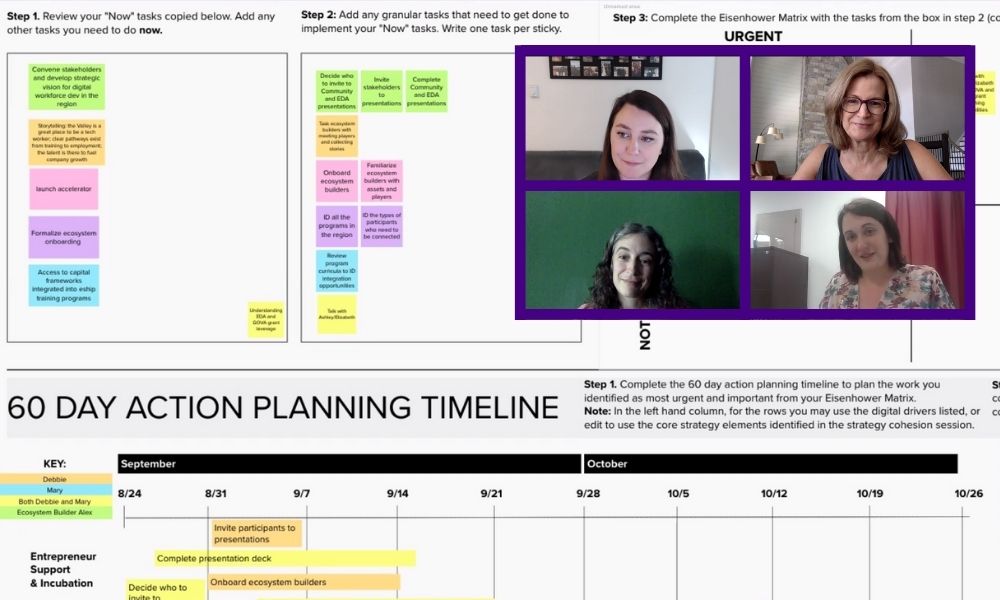JMU earns national rural innovation recognition and collaborates on $1 million grant
Research
Despite the unprecedented challenges brought on by the COVID-19 pandemic, the network of professionals supporting the Shenandoah Valley’s entrepreneurial ecosystem continues to pursue inclusive planning efforts to help the region reach new heights for innovation and venture creation. In order to learn more about these efforts, we sat down (virtually) with Research & Scholarship team member Mary Lou Bourne, Director of James Madison University’s Office of Technology Innovation & Economic Development (TI-ED) and Executive Director of James Madison Innovations, Inc.
The TI-ED office provides a number of services for both JMU faculty and students, including education on the intellectual property protection process and prior art search, patent applications, competitive analysis, and connections to business planning functions. TI-ED also assists JMU in realizing its vision to be the national model for the engaged university, by maintaining connections with external partners pursuing the shared goal of moving innovations into the marketplace.
Emphasizing the importance of a regional approach that includes a seat at the table for higher education, Bourne describes her role as “inclusive to bring together stakeholders focused on entrepreneurs and small businesses from up and down the Valley [while] helping to connect the dots between the technical and business communities.”
Startup Shenandoah Valley
This regional and inclusive approach was on full display as a team of economic development professionals developed, submitted, and received a grant award from GO Virginia, a statewide economic development initiative that encourages collaboration between industry, education, and government to create high-paying jobs and grow private sector investment in the Commonwealth. According to a press release from the lead partner -- the Staunton Creative Community Fund -- the Startup Shenandoah Valley project will “fund virtual acceleration programming, infrastructure buildout, and ecosystem builders across the region for an investment total of over $1 million.”
Part of the proposal development process catalogued what entrepreneurial assets currently exist and what items are necessary to take the region to the next level. Bourne explained, “We created a chart that shows the various resources we have in the Valley and highlights what is missing. Visually depicting our entrepreneurial resources is extremely helpful to see the full picture of what the Valley offers across the region and in various localities.”
Bourne also stressed the importance of the virtual programming, which was a planned component even before the pandemic moved most business interactions online, commenting, “The grant proposal was developed in response to data collected from a survey of entrepreneurs in October 2019 that identified the need for virtual resources that could be accessed throughout the Shenandoah Valley region.”
The project funder -- GO Virginia -- consists of nine regions, each with unique economic development and workforce needs. As a Region 8 initiative, Startup Shenandoah Valley will place an emphasis on entrepreneurs with business ideas in the following sectors: food processing, light manufacturing, information technology, cybersecurity, and biomedical/biotechnology. Part of the grant funding will go toward hiring two ecosystem builders to support the network, buildout infrastructure, and manage programs.
Under Bourne’s leadership, JMU will support the grant through both marketing and convener roles, ensuring those in the Shenandoah Valley are aware of the resources offered by the virtual accelerator and helping to establish connections and synergy between subject matter experts. Additionally, JMU’s Gilliam Center for Entrepreneurship will assist by advising startups and informing one of the most creative groups in the region – JMU students – about the various resources available to them.
With more and more young professionals seeking a balanced work-life pace and both urban and outdoor recreation options in communities like Harrisonburg, Bourne described a potential scenario, “Students enroll in a JMU X-Labs course, work on a real-world problem, develop an idea, and 16 weeks later we can connect them with ICAP (the Innovation Commercialization Assistance Program) for customer discovery, refining business models, and identifying market demand, as well as to existing JMU resources in the Gilliam Center. But what happens after the students graduate? Motivated alumni can take advantage of what will be highly visible resources offered through Startup Shenandoah Valley, and stay local to establish and grow a successful business. That’s the goal.”
Cultivating Entrepreneurship Report
While the GO Virginia funding focuses on future efforts, a new report from the Center on Rural Innovation (CORI) recognized JMU’s longstanding role building the capacity to foster innovation in a rural setting. Cultivating Entrepreneurship: Higher Ed’s Role in Rural Innovation Ecosystems profiles 10 universities from nine states that are “taking an active role in spurring innovation and entrepreneurship in their communities.”
The JMU profile discusses efforts to bring together business, government, higher education, and local community organizations to support technology investment, purposeful asset mapping to better coordinate resources and priorities throughout the region, and Bourne’s service on GO Virginia Region 8’s Entrepreneurial Ecosystem Advisory Committee.
When asked how the report authors identified JMU as a national leader in rural innovation, Bourne responded about the importance of visibility and telling the story, “Once a region appears on the radar with focused goals to support and grow the entrepreneurial ecosystem, good things going on there are noticed which creates a positive feedback loop. In our region’s case, a web presence highlighting resources like the Shenandoah Valley Innovation Coalition, the Shenandoah Valley Angel Investors, and the Staunton Creative Community Fund, coupled with the region winning grant awards and recent stories by Virginia Business, the Virginia Economic Development Partnership, and local media outlets, paint a picture of a region that is primed for innovation and entrepreneurs to flourish.”
